British monsters of World War II. TOG 1 and TOG 2 heavy tanks
Even before the start of World War 2, it became clear that the multi-tower scheme had lost its former relevance. Tanks like А1Е1 or Т-35 in the presence of a huge number of barrels had thin armor, and therefore did not fit the role of "infantry" at all. We didn’t want to spend efforts and funds on the development of fundamentally new machines. Hence it was concluded that the RTC is absolutely necessary analogue of the ancient Mk.VIII "Liberty", but performed at a qualitatively new level.
A discussion of tank requirements for combat in Europe took place in July 1939. It is noteworthy that the British Minister of Supply and Sir Albert Stern, who headed the Department of Supply with tanks during the First World War, participated in the discussion. Obviously, both the honorable gentlemen believed that the Germans would certainly strike at the “Maginot Line”, the fortifications of which allowed it to withstand a long siege. And here you can not do without the experience of senior comrades. The result was quite logical - 5 of September, Sir Albert Stern, received an offer to form a committee and work with tank specialists to develop requirements for a heavy tank. The committee also included Sir U. Tennison D'Encourt, General Swinton, Mr. Ricardo and Major Walter Wilson. In addition, Stern invited Sir William Triton from Foster to assist in the development of a new car. All these people in 1914-1918's. were directly involved in the design and construction of the famous “rhombuses”, whose running gear was perfectly suited for overcoming the field obstacles.

Soon, the committee requested the General Staff of the British Army to issue demands for a heavy tank, for which an offer was received to visit France and get acquainted with the design of the allied tanks. At the same time it was supposed to find out the opinion of the officers of the headquarters of the British Expeditionary Force. Obviously, the desire of the military did not differ much from the committee’s opinion on how a heavy tank should be. As an example, "loomed" French tank B1bis, possessed all the necessary qualities, but did not possess sufficiently strong weapons. However, the layout of this machine repeated the technical solutions of the late “diamonds”, which were once planned to install a weapon in front of the hull. So it is not surprising that the orthodox tank builders decided to combine the old and the new, ahead of their allies.
In October, the committee 1939, which was given the official name “Committee for the development of a special machine of the Ministry of Supply,” finally received a full-fledged technical task. The design of the tank provided for an elongated body and a tracked propulsion unit, completely covering it in height and length. Reservations of the hull should have been reliably protected from hitting 37-mm anti-tank guns and 105-mm field howitzers at a distance of 100 yards (91 meter). The tank’s own armament could be divided into two types: the cannon in the front hull sheet was designed to destroy field fortifications, and two 40-mm cannons and two 7,92-mm BESA machine guns in the airborne sponsors were supposed to be used for “stripping” enemy trenches. The speed was limited to 5 miles / h (8 km / h), and the cruising range did not exceed 50 miles (82 km). Such low road performance resulted from the concept of an “infantry tank” - it was believed that vehicles of this type should not “run away” from infantry. To the front edge of the front, the tank would be delivered by rail.
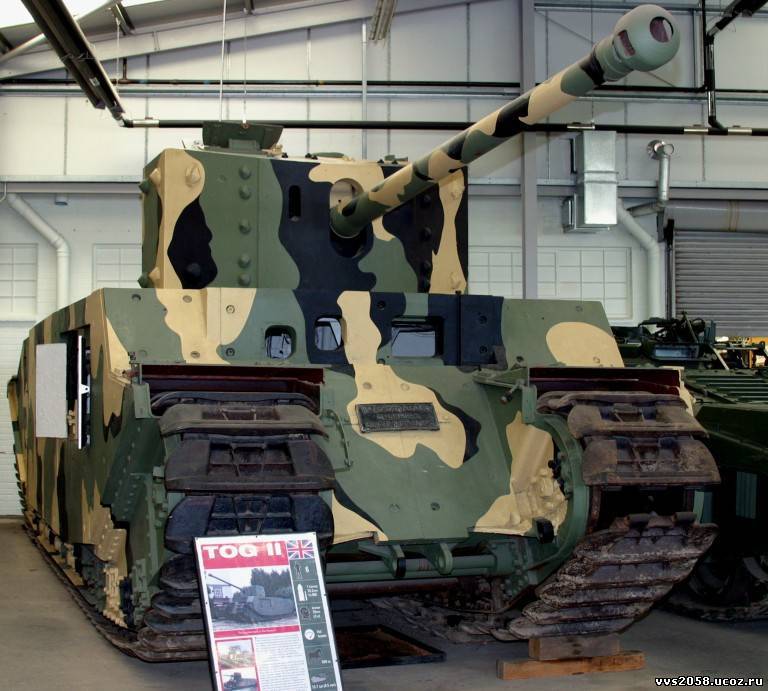
The military department, apparently wanting to play it safe, issued TTZ to two firms at once - Foster and Harland & Wollf. On the side of the first, the same Committee worked, which applied for itself the abbreviation TOG, which meant “The Old Gang” (old gang). The same name was applied to the tank, although the designation TOG 1 (TOG # 1) was also used. In addition, the terms of reference provided for the installation of a diesel engine.
Thus, the conceptual design of TOG, presented in December 1939 of the year, was a combination of cutting-edge technical ideas and explicit anachronisms. The “old gang” did not deny itself the pleasure of developing a multi-wheel undercarriage with a rigid suspension without elastic elements. This greatly simplified the design and reduced its weight. Nevertheless, the design weight of the tank was estimated at 50 tons without sponsons, weapons and ammunition, and a powerful diesel engine has not yet appeared. Instead, they proposed to use the V-shaped 12-cylinder diesel Pacsman-Ricardo horsepower 450 hp, which was planned to be forced to the 600 hp. The crew consisted of a 8 man: a commander, a driver, a front gun gunner, a loader, and four tank crew in sponsons.
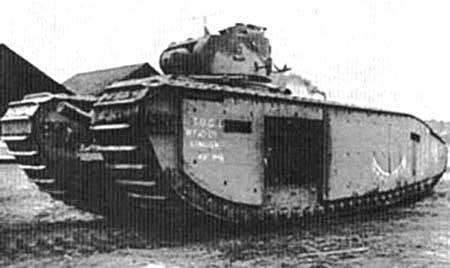
Already at this stage of the design, two miscalculations became immediately apparent. First of all, the armament scheme clearly did not correspond to the realities of the modern war. Onboard sponsons had to be removed, and now on the roof of the hull it was supposed to install a tower with a circular rotation. The second major problem was the transmission. Considering the mass of the tank, the plan with a planetary mechanism, initially proposed by William Wilson, was unacceptable and then the company had to engage the English Electric Company, which was engaged in the development of the electric transmission of the original scheme, which consisted in the following. On the TOG, the engine rotated an electric generator that fed two onboard engines that rotated the tracks. The steering wheel was connected with a potentiometer that changed the voltage on the onboard electric motors and the difference in the speed of rotation of the tracks led to the rotation of the machine.
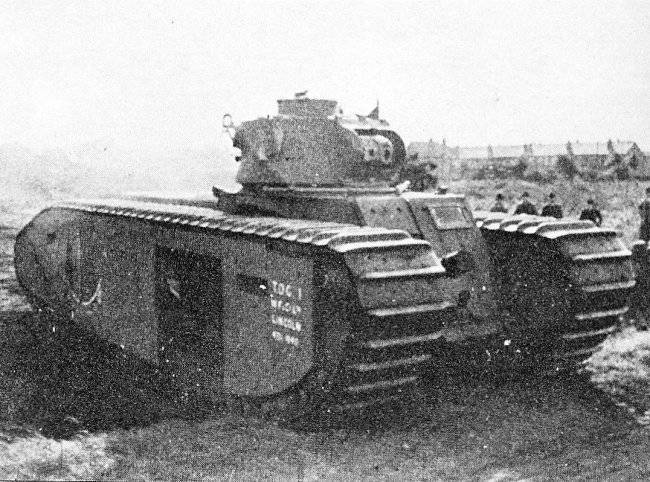
In a revised form, the project was accepted for implementation in February 1940, and in October, Foster completed the assembly of the first prototype. The developers managed to keep the “dry” tons in the 50, but the corps still retained the cutouts for the sponsors, and a tower from the Matilda II infantry tank was installed on the roof. All TOG armament consisted of a 75-mm in the front hull and a twin installation of an 40-mm cannon and one 7,92-mm machine gun in the turret. In order to compensate for the increased load on the ground, it was also necessary to introduce wide tracked tracks.
The tests of the prototype tank TOG lasted long and difficult. The tank entered 27 on September for running tests, and on November X, it was shown to representatives of the army and the Ministry of Supply (Ministry of Supply - MoF). The mass of the tank with a tower from the “Matilda II” and without sponsons was 6 kg. In the process of testing the power plant is constantly pursued problems with overheating, which could not be eliminated. Not surprisingly, the engine and transmission were eventually disabled. Another problem was the low adaptability of the design of the transmission for installation on the tank, whose work led to the deformation of the tracks and guide wheels.
At the same time, in terms of the main driving characteristics, the Ministry was quite satisfied with the TOG. The main test cycle was completed in June 1941 of the year, but MoF insisted on continuing the work on the TOG.
To correct the identified deficiencies, a hydraulic-type transmission was installed on the prototype, after which the tank was designated TOG 1А. This option also proved unsuccessful due to the large inertia of the hydraulic pairs that made the control unreliable. And yet, tests with hydraulic drive began in May 1943, and a month later the tank was returned to the factory for further refinement. The latest TOG 1A data refer to April-May 1944, when the upgraded prototype passed an additional series of tests. After that, the tank was sent to Chobham, where his tracks are lost.
Despite the fact that the positional war on the Western Front had long ago ended with the capitulation of France and the need for such a tank disappeared by itself, under the influence of Sir W. Churchill and some other officials who were burning with the desire to put the new “diamond” into use, the work on the TOG continued. The order for the modified TOG 2 prototype (TOG No. 2) was received on 6 in May 1940.
To improve the technical performance required more radical measures aimed primarily at reducing weight. As a result, the updated model received a chassis of lesser height, and the sponsons were left, but the gun in the front hull sheet was still dismantled. Now the main armament, consisting of 57-mm guns, was to be placed in the turret of a new design. Guns and machine guns in the sponsons remained, but the sponsons themselves were never installed. However, it was also not possible to immediately get a new tower, so instead of it, a wooden mock-up of a simpler form with a fake gun was temporarily installed. The diesel-electric transmission was retained, despite overheating problems that were constantly being pursued by the TOG 1. The changes were as follows.
The driving engine of the two main generators was a diesel engine, which was mechanically connected to the generators.
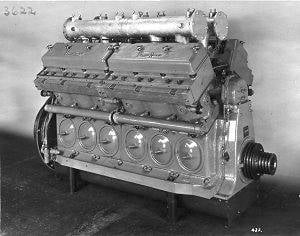
The generators fed the electric motors of each side. Changing the speed of the car was carried out by the diesel engine fuel pedal. A manual lever for changing the resistance of the current supplying the electric motor and the generator provided additional adjustment of the speed of the machine. By turning the rudder connected with the potentiometer, the resistance of the current in the excitation windings of two generators was changed. As a result of turning the steering wheel in one direction or another, the output power of the opposite side electric motor (opposite steering turn) increased due to an increase in voltage in its windings. Another electric motor, powered by its generator, transmitted power to the drive wheel of the other side, helping to make a turn. This was one of the ways of independently reversing one of the electric motors and turning the tank in place (turning around its axis). To make a turn with a radius equal to the width of the tank, one of the tracks was braked using air brakes.
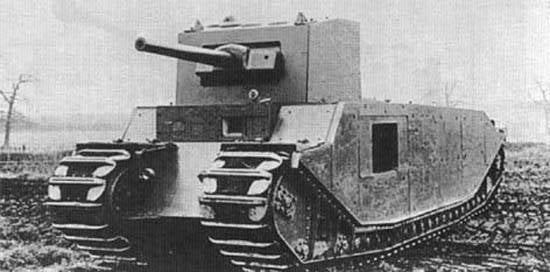
The prototype of the TOG 2 infantry tank made the first factory runs of the 16 March 1941. No further comments revealed any further tests, but the time was hopelessly lost. The tank had a maximum speed of 14 km / h and a power reserve of up to 112 km. Thanks to its undercarriage, the TOG 2 could overcome vertical walls up to 2,1 m in height and trenches up to 6,4 meters in width, which certainly was an impressive result. Six months later, they decided to make new changes to the design of the tank, and therefore its name changed to TOG 2 *
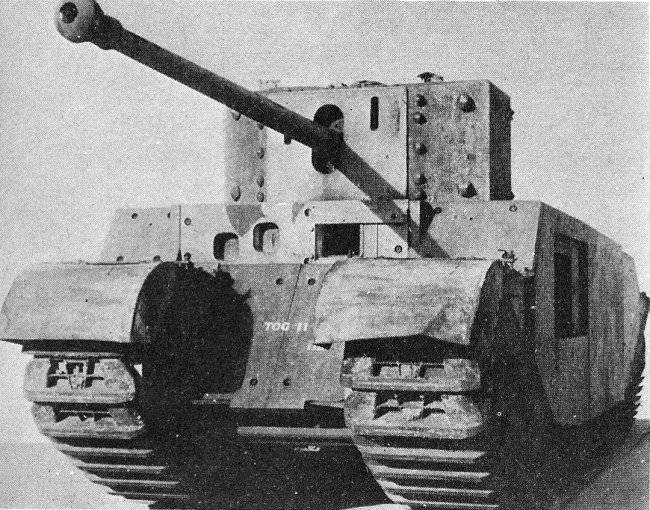
The most important refinement was the use of torsion bar suspension, which provided the best driving performance. In addition to this, a new turret and a 76,2-mm cannon were finally installed on the tank.
The tests, which began in April 1943, confirmed that the TOG 2 * is the heaviest (more than 81 tons) and the most powerful British tank, but the concept by which it was built was outdated. Even in spite of the strong booking, the TOG was inferior in dynamic qualities and armament not only to the German “Tiger”, but even to the weaker Pz.Kpfw.IV with a long-barreled 75-mm gun. Maneuvering war for such machines was disastrous.
However, in 1942, work began on the design of the TOG 2R modification (revised, revised), which was intended to reduce the length of the undercarriage due to the final rejection of sponsors, while maintaining the torsion bar suspension, 76,2-mm turret guns and power towers . Further development of the heavy infantry tank led to the TOG 3 project. However, none of them has been implemented.
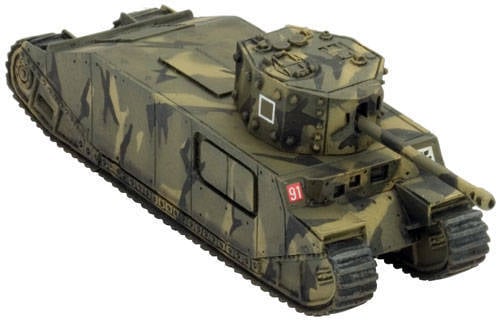
Unlike TOG 1A, the fate of TOG 2 * turned out to be happier. After the war, the tank was sent to the warehouse, from where it was soon removed, repaired and transferred to the tank museum in Bovington. By the way, the Paxman engine remained “native” on it, although the tank is not on the move now.
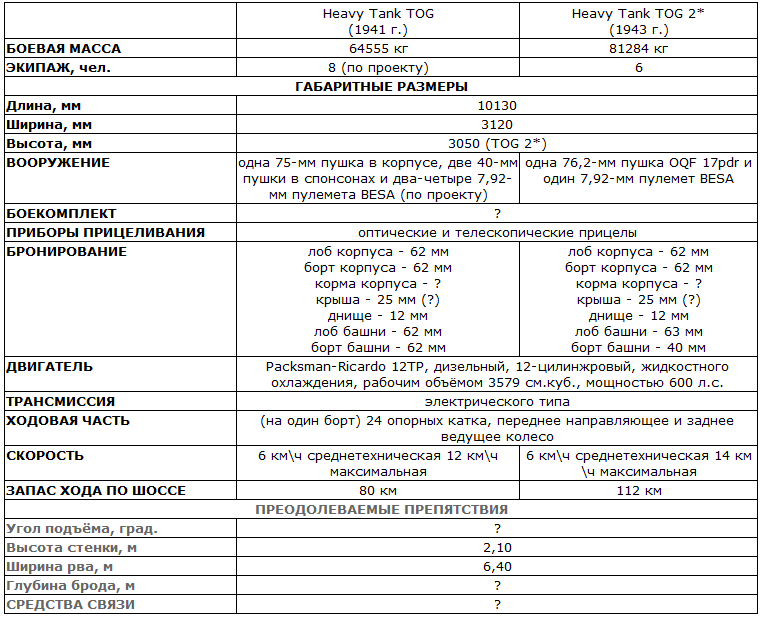
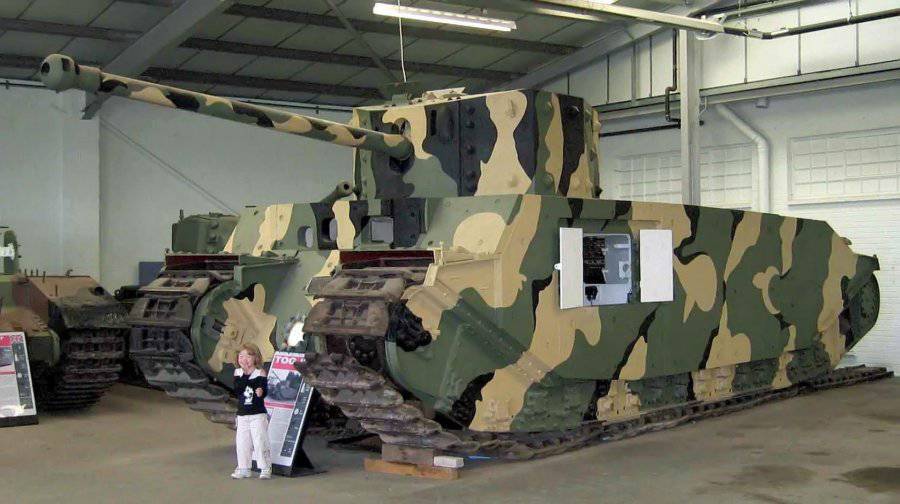
Information